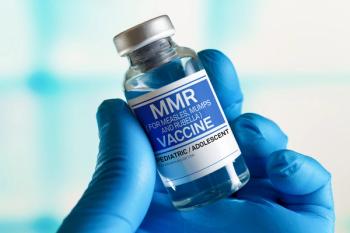
Metal Ion Chelators Hold Enormous Potential in Neurodegenerative Disorders
Monitoring metal ion concentrations and chelation therapy is hypothesized to alleviate symptoms and diseases caused by neuroinflammation.
Current treatment strategies for neurodegenerative disorders are disease-specific and only serve to mitigate the symptoms of the underlying disease. However, utilizing metal chelators as a therapeutic intervention against neurodegenerative disorders could prove to be a promising avenue.
Neurodegenerative disorders impact an individual's abilities, ranging from simple tasks such as speech and movement to complex functions such as cognition. The severity of these disorders depends on the type and stage of the disease.1 Primarily linked to factors such as aging, genetic predisposition, and environmental influences, neurodegenerative diseases encompass conditions like Alzheimer disease (AD), Parkinson disease (PD), Prion diseases, amyotrophic lateral sclerosis (ALS), spinal muscular atrophy, spinocerebellar ataxia, and Huntington disease, and present considerable challenges in the fields of both medicine and society.
These disorders exhibit unique pathology and mechanisms, yet share common features such as abnormal protein aggregation in the brain, formation of neurofibrillary tangles, mitochondrial dysfunction, and oxidative stress. These events result from the activation of specific mediators that trigger a neuroinflammatory cascade, causing neuronal loss and damage.2
The brain and central nervous system rely on metal ions as essential cofactors for various proteins and chemical reactions.3 Metal ions, including zinc, iron, and copper, enter the brain by surpassing the blood-brain barrier. Their deficiency or over-accumulation can lead to oxidative damage, protein aggregation, and mitochondrial dysfunction, contributing to the pathogenesis of neuronal disorders.4,5
Research has demonstrated that the abnormal presence of such metal ions in regions of the brain results in high amyloid-beta (Aβ) deposition, tau hyperphosphorylation, neuronal loss, and neuroinflammation associated with these disorders.6 Further investigation has uncovered that these metal ions can increase Aβ protein production and enhance its aggregation.6 Monitoring metal ion concentrations and chelation therapy is hypothesized to alleviate symptoms and diseases caused by neuroinflammation.6 Metal ion chelation—blocking metal ions from binding to other molecules in the body—is a potential therapeutic approach.7
Biometals and Toxic Metals
Metals can be classified as either biometals and toxic metals. Essential for regular bodily functions, biometals are needed in varying quantities. These include calcium, magnesium, potassium, sodium, cobalt, copper, chromium, iron, manganese, molybdenum, selenium, and zinc. On the other hand, toxic metals like arsenic, cadmium, lead, and mercury can be detrimental to the human body. When the metabolism of biometals is impaired, the excess accumulation of any of them can promote the synthesis of reactive oxygen species, which are damaging to proteins, lipids, and DNA.8
Although drug molecules have shown promise in mitigating disease progression, limitations in bioavailability or efficacy prevent their approval for primary treatment. Addressing various pathological variables is crucial in developing effective therapies for these challenging disorders.
One potential approach involves binding metal ions to chelating agents, forming complexes that are more easily eliminated from the brain endothelium than individual ion species. However, a significant limitation of chelation therapy is its restricted targets and low permeability to the brain due to the blood-brain barrier.
Metal-Ion Chelators and Neurodegerative Disease: Are They Related?
Metal ion chelators exhibit the capability to bind to multiple ions simultaneously through coordinated bond formation.8 Sodium edetate (EDTA), administered orally, intramuscularly, or intravenously, serves as an effective chelating agent, facilitating the excretion of metals present in toxic proportions. Chelation tests involving EDTA can identify concentration of excess metals in the brain. In cases where multiple toxic metals are present simultaneously, EDTA is involved in chelating and excreting all toxic metals.9
For AD, the absence of a definitive treatment arises from the lack of a single effective pathogenic target.8 Aducanumab (Aduhelm) has been approved by the FDA to clear amyloid beta plaques, and drugs like donepezil (Aricept), galantamine (Razadyne), rivastigmine (Exelon), and memantine (Namenda) address symptoms at the cholinergic system level.10 Zinc, iron, and copper, especially with greater stability, form complexes with Aβ plaques, prompting consideration for a new drug entity focusing on copper chelation at multiple target sites.11 Alternative approaches involving the chelation of metal ions and the dissolution of Aβ plaques are being explored, with molecules like 3-metallothionein and desferrioxamine showing potential neuroprotective properties.8,12
ALS involves protein aggregation leading to damage in the brainstem and spinal cord.13 Approved drugs for ALS include riluzole (Rilutek), which is a glutamate receptor antagonist, and edaravone (Radicava), which is an antioxidant and free-radical scavenger. Copper ion accumulation in the spinal cord of patients with ALS necessitates chelation therapy, and agents like D-penicillamine, trientine, and DP-480 form chelation complexes to delay the onset and slow its progression.8
PD treatment options are limited, with levodopa (Rytary) being the most effective but causing chronic motor abnormalities. Dopaminergic agonists like pramipexole (Mirapex) and highly selective dopamine agonists such as tavapadon show promise for early PD. Incorporating iron chelators such as desferroxamine, clioquine, VK-28, and M-30 into the therapeutic regimen may reduce dose concentration and prevent iron-induced oxidative stress.8,14
Polyphenols, secondary plant metabolites, act as metal ion chelators providing neuroprotection against oxidative stress. Sourced from various vegetables, polyphenols such as phenolic acids, lignans, stilbenes, hydroxybenzoic acid, hydroxycinnamic acid, and flavonoids mitigate metal accumulation and toxicity.15 Their variable antioxidant effects contribute to decreasing inflammation and organ damage, while their pro-oxidant property in the presence of redox-active transition metals is linked to the anti-apoptotic property.16
Conclusion
The potential of metal ion chelators for neurodegenerative disorders stands as a promising avenue for therapeutic intervention. The intricate interplay of metal ions is both essential for regular bodily functions and toxic when imbalanced, which underscores the importance of maintaining their proper concentrations. As we navigate the complex landscape of neurodegenerative diseases, the limitations of current treatments highlight the need for innovative approaches. Metal chelation therapy emerges as a beacon of hope, offering a means to address the aberrant presence of metal ions associated with neurodegenerative disorders. The ongoing exploration of alternative strategies, such as the dissolution of amyloid beta plaques and the neuroprotective properties of polyphenols, adds to our understanding and opens new possibilities for effective interventions.
References
1. Lamptey RNL, Chaulagain B, Trivedi R, Gothwal A, Layek B, Singh J. A review of the common neurodegenerative disorders: current therapeutic approaches and the potential role of nanotherapeutics. Int J Mol Sci. 2022;23:1851. doi:10.3390/ijms23031851
2. Guzman-Martinez L, Maccioni RB, Andrade V, Navarrete LP, Pastor MG, Ramos-Escobar N. Neuroinflammation as a common feature of neurodegenerative disorders. Front Pharmacol. 2019;10:1008. doi:10.3389/fphar.2019.01008
3. Chaudhari V, Bagwe-Parab S, Buttar HS, Gupta S, Vora A, Kaur G. Challenges and opportunities of metal chelation therapy in trace metals overload-induced Alzheimer disease. Neurotox Res. 2023;41(3):270-287. doi:10.1007/s12640-023-00634-7
4. Doroszkiewicz J, Farhan JA, Mroczko J, Winkel I, Perkowski M, Mroczko B. Common and trace metals in Alzheimer’s and Parkinson’s diseases. Int J Mol Sci. 2023;24(21):15721. doi:10.3390/ijms242115721
5. Kawahara M, Kato-Negishi M, Tanaka KI. Dietary trace elements and the pathogenesis of neurodegenerative diseases. Nutrients. 2023;15(9):2067. doi:10.3390/nu15092067
6. Chen LL, Fan YG, Zhao LX, Xhang Q, Wang ZY. The metal ion hypothesis of Alzheimer’s disease and the anti-neuroinflammatory effect of metal chelators. Bioorg Chem. 2023;131:106301. doi:10.1016/j.bioorg.2022.106301
7. Thakur R, Karwasra R, Umar T. Understanding Alzheimer’s disease and its metal chelation therapeutics: a narrative review. Curr Pharm Des. 2023;29(3):2377-2386. doi:10.2174/0113816128263992231012113847
8. Leal MFC, Catarino RIL, Pimenta AM, Souto MRS. Metal chelators as part of a strategy for the treatment of neurodegenerative diseases. Trace Elem and Electr. 2023;40:126-138. doi:10.5414/TE500056
9. Ferrero ME. Neuron protection by EDTA may explain the successful outcomes of toxic metal chelation therapy in neurodegenerative diseases. Biomedicines. 2022;10(10):2476. doi:10.3390/biomedicines10102476
10. Pardo-Moreno T, Gonzalez-Acedo A,Rivas-Dominguez A, et al. Therapeutic approach to Alzheimer’s disease: current treatments and new perspectives. Pharmaceutics. 2022;14(6):1117. doi:10.3390/pharmaceutics14061117
11. Spiegel M, Marino T, Prejano M, Russo N. Antioxidant and copper-chelating power of new molecules suggested as multiple target agents against Alzheimer’s disease: A theoretical comparative study. Phys Chem Chem Phys. 2022;24:16353-16359. doi:10.1039/D2CP01918C
12. Grange C, Aigle A, Ehrlich V, Ariza JFS, et al. Design of a water-soluble chitosan-based polymer with antioxidant and chelating properties for labile iron extraction. Nature. 2023;13:7920. doi:10.1038/s41598-023-34251-3
13. Mead RJ, Shan N, Reiser HJ, Marshall F, Shaw PJ. Amyotrophic lateral sclerosis: a neurodegenerative disorder poised for successful therapeutic translation. Nat Rev Drug Discov. 2023;22:185-212. doi:10.1038/s41573-022-00612-2
14. Di Luca DG, Reyes NGD, Fox SH. Newly approved and investigational drugs for motor symptom control in Parkinson’s disease. Drugs. 2022;82(10):1027-1053. doi:10.1007/s40265-022-10747-7
15. Raja TRW, Duraipandiyan V, Ignacimuthu S, Janakiraman U, Packiam SM. Role of polyphenols in alleviating Alzheimer’s disease: a review. Curr Med Chem. 2023;30(35):4032-4047. doi:10.2174/0929867330666221202152540
16. Renu K, Mukherjee AG, Gopalakrishnan AV, Wanjari UR, et al. Protective effects of macromolecular polyphenols, metals (zinc, selenium, and copper) – polyphenol complexes, and different organs with an emphasis on arsenic poisoning: A review. Int J Biol Macromol. 2023;253(Pt 4):126715. doi:10.1016/j.ijbiomac.2023.126715.
Newsletter
Stay informed on drug updates, treatment guidelines, and pharmacy practice trends—subscribe to Pharmacy Times for weekly clinical insights.













































































































































































































